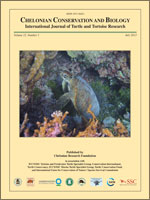Astrochelys radiata is one of the threatened tortoise species of Madagascar. We studied their home range size, use of shelters, and diet in Tsimanampetsotsa National Park. The goal was to identify suitable habitats and food chemistry. These data could serve as bases for future evaluations of the suitability of habitats under altered environmental conditions, such as degradation and climate change. The study was performed with the help of radio-tracking in two different types of vegetation: dry deciduous forest on sand and spiny bush on limestone between November 2007 and October 2008. Monthly range sizes were 2.3 ha in the littoral forest and 1.4 ha on the limestone massif when calculated with the kernel method. Based on the minimum convex polygon, the values were 1.0 and 0.5 ha, respectively. Monthly range size did not vary significantly between sexes, but range sizes were larger in the littoral forest than on limestone. A. radiata chose shelters under trees with large trunk diameters (> 15-cm DBH) and lower heights than trees in representative samples in the habitats. Plant items eaten and not eaten by this species were analyzed for primary and secondary plant chemicals. A. radiata consumed a wide variety of plants. Its diet was composed of leaves (91%), flowers (5%), and fruits (4%) from 109 plant species. During the dry season, high energy content was the most important factor for food selection by A. radiata.
How to translate text using browser tools
1 July 2013
Habitat Use and Diet of Astrochelys radiata in the Subarid Zone of Southern Madagascar
ACCESS THE FULL ARTICLE

Chelonian Conservation and Biology
Vol. 12 • No. 1
July 2013
Vol. 12 • No. 1
July 2013
food chemistry
home range
life history
nutrition
Reptilia
Seasonality
shelter




